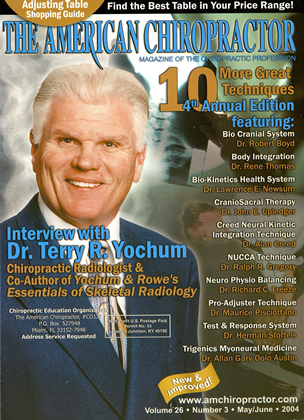C URRF.NT RESEARCH DESCRIBES THE AD-vantage of early, progressive rehabilitation exercise for many types of joint conditions."' These ben- efils include: restoration of range of motion; decreased pain and swelling; decreased neural inhibition; quicker return of muscle function; and improved performance in sports and all daily activities. Some studies even speculate that early rehabilitation programs may reduce the number of joint re-injuries.7'' Contemporary concepts in joint rehabilitation emphasize functional activities and re-training of normal loading and movement patterns. 11 is especially important to regain full neurological coordination of the surrounding muscles and connective tissues, because that is the true source of joint stability. An important component in addressing these needs can be the frequent use of exercise tubing. The Values of Functional Rehab and Elastic Tubing The proprioceptive input from receptors in the muscles, connective tissues, and joint capsules differs when going from standing to lying down. That is why it is so important to bring joint rehab exercises closer to real-life positions, and it explains why patients can progress much more quickly when they are instructed to exercise in a functional position. Exercises done on the floor, on a weight bench, or constrained by a machine may not train muscles and joints to function optimally during usual daily or sports activities. The neurological patterns that are developed on the floor or in a pool are considered preliminary to the joint function during upright demands. Learning new skills and movement habits in a machine doesn't always translate to better functioning during regular, independent activities, or improved sports performance. Some of the time patients spend on open chain exercises for their lower extremities may be unnecessary. In addition, it's expensive to get patients into a facility with machines, or a pool to exercise. Elastic tubing allows patients to exercise in a weight-bearing, functional position that has been shown to be both effective and safe.' It has the additional benefit of being easier for most patients. In addition to being more focused and practical, upright exercising trains and strengthens the joints to perform better in everyday activities. ■ Resistance Variation: Elastic tubing provides a unique form of exercise. The actual amount of resistance varies significantly with the amount of stretch applied to the tubing.1" This attribute is used most effectively by initiating the rehab program with some slack in the tubing, thereby ensuring relatively low resistance. As the patient improves, the exercise is performed with less slack, increasing the resistance gradually and safely. Eventually, the exercise effort progresses to starting with some "pre-stretch," in order to stimulate and activate a more widespread neurological response to the exercise movement. In this way, most patients are able to advance through their entire joint rehab program with just one exercise tubing design, rather than having to purchase several dilTerent levels When provided to a patient, the exercise tubing generally needs to be accompanied by a strap device and/or handles, along with an illustrated, descriptive exercise booklet. It should also be packaged with a system for temporary, but dependable, attachment to a door or wall (such as straps or clips). Even with these additional necessary items, exercise tubing is both lightweight and inexpensive. It is easily carried on business and vacation trips to provide continuous rehab. ■ Additional Advantages: Exercise tubing is also very non-threatening, and has been used extensively in home-based exercise programs for older adults." Since setup is easy to learn, and requires little manual dexterity, it can be used by patients with no gym experience.12 An additional benefit is being able to customize sports equipment with elas- tic tubing to provide very sport-specific joint rehab. Exercise tubing is commonly used with tennis racquets and golf clubs to enhance performance and prevent in- jury.11 Early Involvement for Best Results Appropriate and progressive rehab programs should be started early in the treatment of patients with joint conditions— both acute and chronic. Retraining programs using simple, isotonic resistance techniques are readily available, none of which require expensive equipment or great time commitments. A closely monitored home exercise program using exercise tubing is recommended, since this allows the doctor of chiropractic to provide cost-efficient, effective, and specific rehabilitative care. EZQ ► Please e-mail: amchiro@amchiropractor for References Kim Christensen DC, DACRB. CCS P. CSCS. directs the Chiropractic Rehab & Wellness program at PeaceHealth Hospital in Longview, Washington. He is a popular speaker, and participates as a team physician and consultant to high school and university athletic programs. Dr. Christensen is currently a postgraduate faculty member of numerous chiropractic colleges and is the past-president of the American Chiropractic Association (ACA) Rehab Council. He is a "Certified Strength and Conditioning Specialist. " certified by the National Strength ami Conditioning Association. Dr. Christensen is the author of numerous publications and texts on muscidoskeletal rehabilitation and nutrition. He can be reached at PeaceHealth Hospital by email at kdirmteiisenlaipeacejiea/lh. org.
 View Full Issue
View Full Issue






